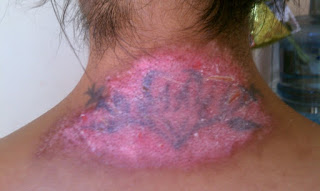What can I do if my tattoo isn't completely faded?
"I went to a removal clinic and after several months of treatment, my tattoo isn't gone! They said there is nothing more they can do to fade it!"
This is probably the most common issue with laser removals. You have a level of fade that leaves the tattoo less visible than before you started but still oddly visible, like a ghost tattoo that someone can still see if they look right at it.
Not a fun place to be.
The good news for you guys who haven't gone through this is that your tattoo is lower risk if it's solid colored. Complicated multicolored tattoos are more difficult to fade because different inks respond in different ways to the ink removal lasers. There's a tendency for part of the tattoo to be more visible than other parts, another reason I recommend doing a cover up as first option (more than just a bit).
High complexity, lower fade
The most difficult tattoos for the lasers are multicolored tattoos that are also highly complex in nature. I'm talking about intricate patterns like sweeping back designs with full on backgrounds and character details down to the hairs and facial gestures. Oh boy, those ones will likely not fade completely.
The more detail, the more ink used. And if some of the tattoo is flesh colored, red, tan, or white, you can be sure that you're looking at a partial removal from the lasers at best.
Natural removal tends to fade more evenly
As natural removal methods exfoliate the skin, bringing the ink to the top, they are less discriminatory in that sense. The amount of ink used and the different types of color/pigment are less of a factor. A lot of my clients are rather surprised after paying a couple thousand dollars to a laser tattoo removal clinic, and then trying a basic exfoliation process and the rest of the tattoo goes away on its own!
Of course you don't need to wait until a laser removal returns a subpar result. Check out my laserless removal guide if you haven't already for lower cost, at home removal methods.: http://getridtattoo.plus101.com
You know why you haven't seen these techniques on TV? Because they're not good moneymakers. They're low-cost and don't require a doctor. Thankfully, ink under the skin isn't a terribly difficult problem to solve, especially with the right ingredients and removal process. http://getridtattoo.plus101.com



